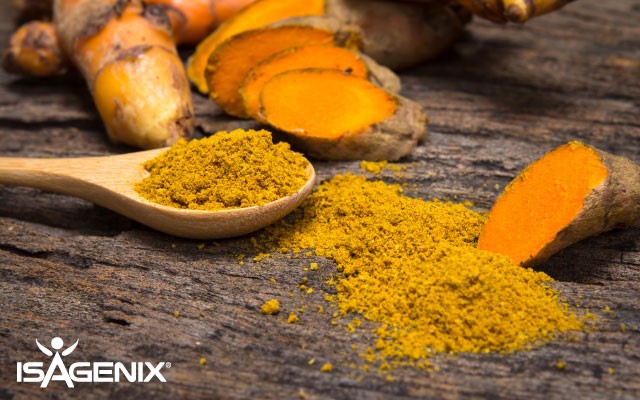
Also referred to as “Indian saffron” or “Indian solid gold,” turmeric is derived from the rhizome of the plant Curcuma longa and is immediately associated with colorful Indian and Asian curries.
But did you know that turmeric is also responsible for the color of mustard as well as functioning as a clothing dye? The pigment even contributes essential religious symbolism for Indian weddings.
So what exactly are the roots of its multifunctional contributions?
Historically, the use of turmeric – which belongs to the same plant family as ginger – dates back 4,000-5,000 years to India and Indonesia. The plant is also mentioned in the writings of Marco Polo during his 1280 journey to China and India. Finally, it was during the British rule of India that turmeric was combined with other spices and labeled as “curry powder” that is so familiar with us today.
Curcumin Is a Major Component of Turmeric
Turmeric contains a wide number of phytochemicals, but the primary component that’s attracted worldwide scientific inquiry is curcumin. Curcumin is the polyphenolic pigment contributing to turmeric’s yellow color and believed to be responsible for most of this spice’s health and wellness benefits. On average, curcumin comprises 2-5 percent of turmeric.
Curcumin itself has been used for millennia as a therapeutic agent in traditional Indian (Ayurveda) and traditional Chinese medicine, and beginning with its first citation in 1937 (1), interest in curcumin by the scientific community has increased substantially. (A search of the terms “curcumin” or “turmeric” on the PubMed website of scientific publications demonstrate this popularity. The number of publications in 2016 alone was greater than the total number of publications from years 1945-2003.)
Health Benefits of Curcumin
Curcumin’s influence on molecular pathways are numerous and complex. It’s not surprising that the pigment could potentially have several health-related benefits, including:
- Support as an antioxidant – The yellow spice can help in the supporting antioxidant defense systems including the antioxidant enzymes superoxide dismutase (SOD) and catalase (2, 3).
- Support against oxidative stress biomarkers – Curcumin has also been shown to reduce cellular oxidative stress mediators in both overweight individuals (4) and those with metabolic syndrome (5).
- Support for heart health – In one study, subjects consuming curcumin reduced their levels of plasma lipids associated with cardiovascular health (6), while in another study, curcumin improved endothelial function and supporting blood flow (7).
- Support for exercise recovery – Young males supplementing with curcumin had reduced exercise-induced oxidative stress (better recovery) compared to those taking a placebo (8).
- Support for brain health – Researchers reported that elderly Asians who consumed curry “occasionally” or “often or very often” reported significantly better mental performance scores compared with subjects who reportedly “never or rarely” consumed curry (9). While this epidemiological study suggests only correlation and not causation, it’s consistent with the increasing accumulation of research implicating curcumin as an important nutraceutical that supports healthy brain aging (10).
Isagenix Offers Several Sources of Curcumin
In addition to Brain Boost & Renewal™, Isagenix also offers other products containing highly purified curcumin. For example, you can also find curcumin in Cleanse for Life®, IsaGenesis®, and CytoActives™. Overall, to enjoy the maximal health benefits of this “Indian solid gold,” incorporate these Isagenix products into your daily dietary supplementation routine, along with the occasional Asian and Indian curry – because it’s delicious!
References
- Oppenheimer A. Turmeric (curcumin) in biliary diseases. Lancet 1937; 229:619-21, 1937.
- DiSilvestro RA, Joseph E, Zhao S et al. Diverse effects of a low dose supplement of lipidated curcumin in healthy middle aged people. Nutr J 2012;11:79, 2012.
- Panahi Y, Hosseini MS, Khalili N et al. Antioxidant and anti-inflammatory effects of curcuminoid-piperine combination in subjects with metabolic syndrome: A randomized controlled trial and an updated meta-analysis. Clin Nutr 2015;34:1101-8.
- Ganjali S, Sahebkar A, Mahdipour E et al. Investigation of the effects of curcumin on serum cytokines in obese individuals: a randomized controlled trial. Scientific World Journal 2014;2014:898361.
- Panahi Y, Hosseini MS, Khalili N et al. Effects of curcumin on serum cytokine concentrations in subjects with metabolic syndrome: A post-hoc analysis of a randomized controlled trial. Biomed Pharmacother 2016;82:578-82.
- Pungcharoenkul K and Thongnopnua P. Effect of different curcuminoid supplement dosages on total in vivo antioxidant capacity and cholesterol levels of healthy human subjects. Phytother Res 2011; 25:1721-6.
- Akazawa N, Choi Y, Miyaki A et al. Curcumin ingestion and exercise training improve vascular endothelial function in postmenopausal women. Nutr Res 2012;32:795-9.
- Takahashi M, Suzuki K, Kim HK et al. Effects of curcumin supplementation on exercise-induced oxidative stress in humans. Int J Sports Med 2014;35:469-75.
- Ng TP, Chiam PC, Lee T et al. Curry consumption and cognitive function in the elderly. Am J Epidemiol 2006;164:898-906.
- Cole GM, Teter B, Frautschy SA. Neuroprotective effects of curcumin. Adv Exp Med Biol 2007;595:197-212.

